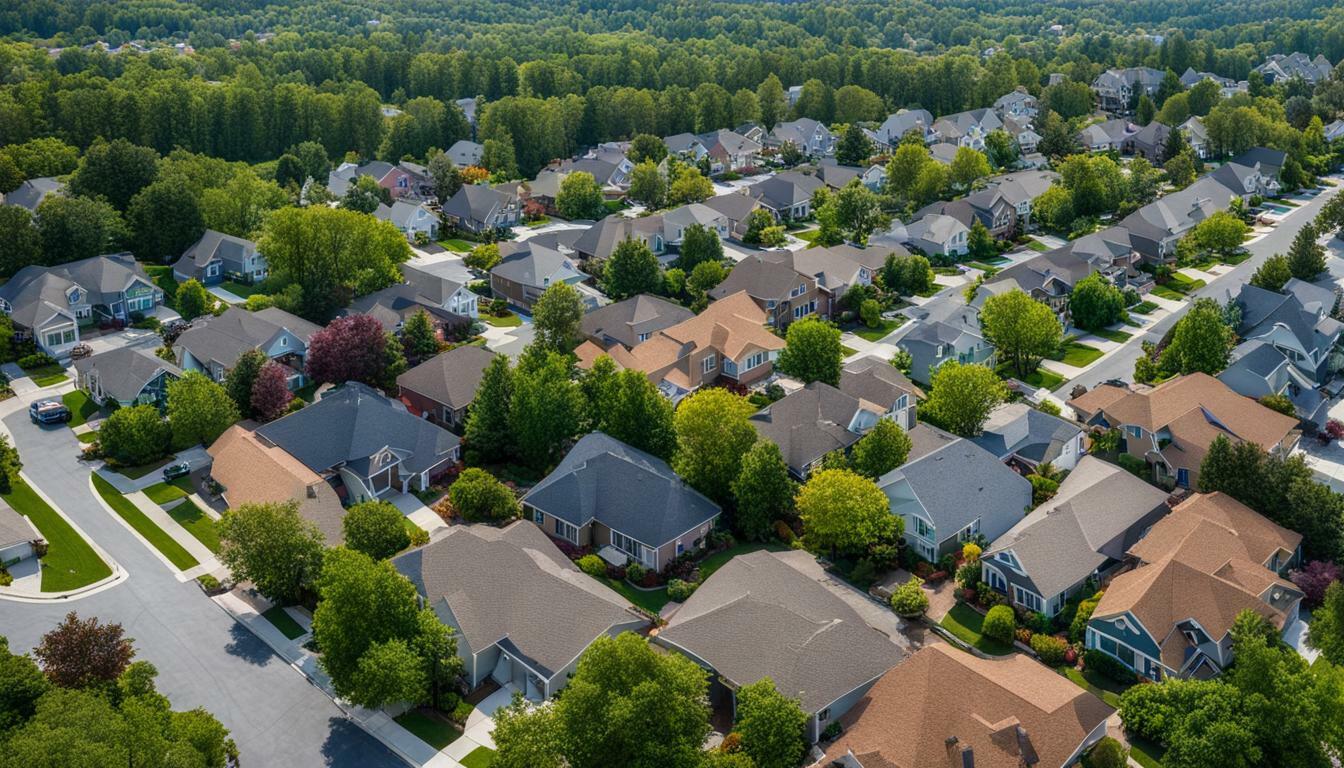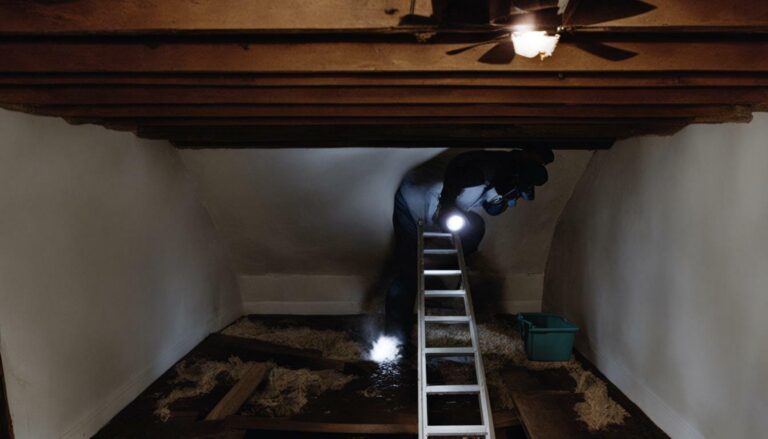Essential Guide: How to Spot Hail Damage on Roofs
Hail damage to roofs can be a significant problem, but it’s not always easy to identify. This guide provides helpful information on how to spot hail damage on roofs, allowing you to take necessary action and prevent further complications. It is crucial to be vigilant and address any potential hail damage promptly to ensure the longevity and integrity of your roof.
Key Takeaways:
- Understanding what hail is and how it forms.
- Recognizing the signs of hail damage, including dented gutters, damage to siding and windowsills, and damage to air conditioners or outdoor items.
- Inspecting roof vents, chimneys, and shingles for hail damage.
- Knowing what hail damage looks like on shingles.
- Considering factors that affect the severity of hail damage, such as wind speed, hailstone size, and roofing materials.
By following the steps outlined in this guide, you can protect your roof against hail damage and minimize the potential for costly repairs. Remember to conduct regular roof inspections, use impact-resistant roofing materials, and trim any trees or shrubs near your roof. If you suspect hail damage, it’s essential to contact a professional roofing contractor, file an insurance claim if necessary, and schedule a thorough roof inspection and repair.
Understanding Hail Damage: What You Need to Know
Before we dive into spotting hail damage, it’s essential to understand what hail is and why it can be detrimental to your roof. Hail is formed when updrafts in thunderstorms carry raindrops upward into extremely cold areas of the atmosphere, where they freeze into ice pellets. These ice pellets are then layered with additional water, creating larger hailstones that fall to the ground.
Hail can cause significant damage to your roof, especially during severe storms. When hailstones impact your roof, they can dent or fracture shingles, dislodge granules, and even penetrate the underlying materials. This damage can compromise the integrity of your roof and lead to leaks, water damage, and costly repairs if not addressed promptly.
To protect your home and ensure the longevity of your roof, it’s crucial to conduct regular roof inspections for hail damage. By detecting hail damage early, you can take the necessary steps to prevent further deterioration and maintain the structural integrity of your roof.
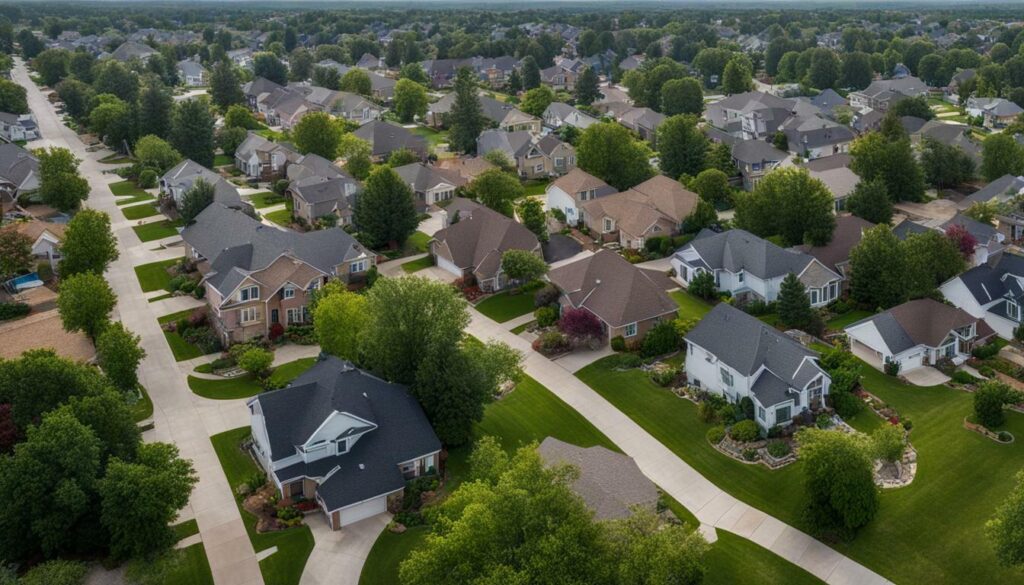
During a roof inspection for hail damage, pay close attention to any visible signs of damage. These can include dented or cracked shingles, missing granules, exposed felt or underlayment, and damaged flashing. Additionally, inspect the gutters, downspouts, vents, chimneys, and other roofing components for any indications of hail impact or dislodged materials.
It’s important to note that hail damage may not always be immediately apparent. Sometimes, it can take months or even years for the effects of hail damage to become noticeable. Therefore, it’s recommended to document any suspected hailstorms with photographs and keep a record of the dates and times they occurred. This documentation can be useful when filing an insurance claim or seeking professional assistance for roof repairs.
Tips for Detecting Hail Damage on Roofs:
- Inspect your roof after severe storms, especially if hail was reported in your area.
- Look for signs of damage, such as dented or cracked shingles, exposed underlayment, or missing granules.
- Examine your gutters, downspouts, and other roof components for any indications of hail impact.
- Take photographs and document the dates of suspected hailstorms for future reference.
- Consider consulting a professional roofing contractor for a thorough roof inspection.
By being proactive and vigilant in detecting hail damage on your roof, you can protect your home, prevent further deterioration, and ensure the longevity of your roof.
| Hail Damage Checklist: | What to Look For: |
|---|---|
| Dented or cracked shingles | Physical damage indicating hail impact |
| Exposed underlayment or felt | Dislodged materials due to hail impact |
| Missing granules | Loss of protective layer on shingles |
| Damaged flashing | Leaks and water infiltration points |
Signs of Hail Damage to Look For
Spotting hail damage on your roof starts with knowing what signs to look for. Hail can cause various types of damage, and recognizing these signs early can help prevent further issues and costly repairs.
One common sign of hail damage is dented gutters. When hailstones hit the gutters, they can leave visible dents or even cause the gutters to crack. Inspecting your gutters after a hailstorm can help identify potential damage.
Damage to siding and windowsills is another indication of hail damage. Look for cracks, chips, or dents on the exterior of your home. Hailstones can also cause damage to air conditioners or outdoor items, so be sure to check these as well.
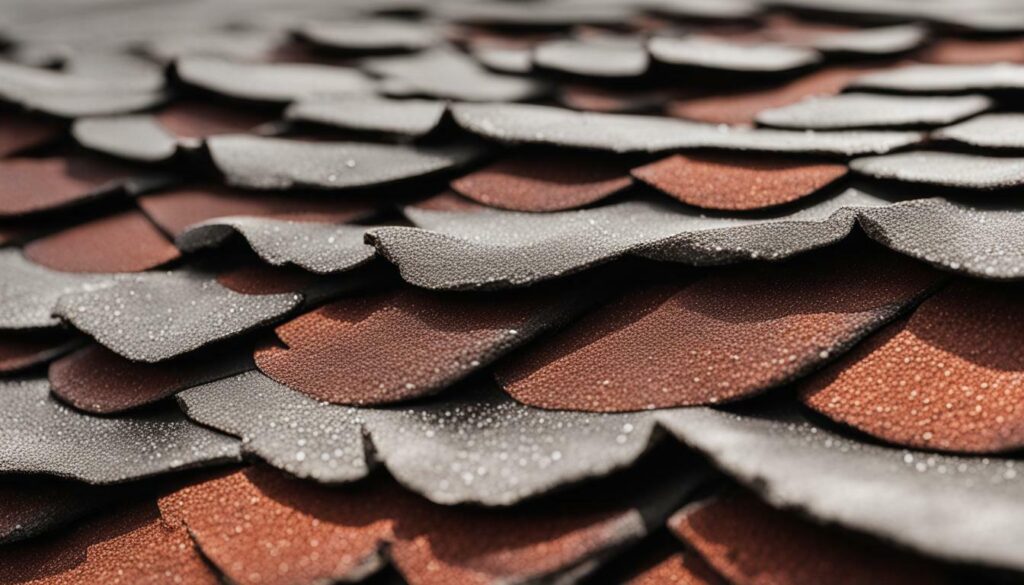
Table 1: Common Signs of Hail Damage
| Signs of Hail Damage | Description |
|---|---|
| Dented Gutters | Visible dents or cracks on the gutters |
| Damage to Siding and Windowsills | Cracks, chips, or dents on the exterior of the home |
| Damage to Air Conditioners or Outdoor Items | Visible damage on outdoor equipment |
Inspecting roof vents, chimneys, and shingles is crucial to determining the extent of hail damage. Look for cracks or granule loss on the shingles, as these can indicate damage. It’s important to assess the condition of these areas thoroughly to ensure any issues are addressed promptly.
Hail damage can vary in severity based on factors such as wind speed, hailstone size and density, and the type of roofing material. Larger hailstones and stronger winds can cause more significant damage, while impact-resistant roofing materials may offer better protection.
“Spotting hail damage on your roof starts with knowing what signs to look for.”
Protecting your roof against hail damage involves proactive measures. Regular roof inspections can help identify potential issues early on and allow for prompt repairs. Using impact-resistant roofing materials can provide added protection against hail damage. Additionally, trimming trees and shrubs near your roof can prevent potential damage from falling branches or debris during a hailstorm.
If you suspect hail damage to your roof, it’s essential to take prompt action. Contact a professional roofing contractor to assess the damage and provide necessary repairs. If needed, file an insurance claim to cover the costs. Schedule a roof inspection to fully assess the extent of the damage and ensure proper repairs are made.
Being able to spot hail damage on roofs is crucial for homeowners. By knowing the signs and taking proactive measures, you can protect your roof from further damage and ensure its longevity.
Inspecting Roof Vents, Chimneys, and Shingles for Hail Damage
To accurately assess hail damage on your roof, it’s crucial to inspect specific areas that are prone to damage. This includes roof vents, chimneys, and shingles. These areas are particularly vulnerable to the impact of hailstones, and a thorough examination is necessary to identify any signs of damage. Here’s how you can inspect these components:
Roof Vents:
Start by examining the roof vents for any visible signs of hail damage. Check for dents or cracks on the vent covers, as well as any missing or loose parts. Hailstones can cause significant damage to these areas, affecting the functionality of your vents. If you notice any issues, it’s important to contact a professional roofing contractor for further assessment and necessary repairs.
Chimneys:
Next, inspect your chimney for any hail damage. Look for cracks or dents on the chimney structure, as well as on the chimney cap. Pay close attention to the mortar joints, as hail impact can weaken the integrity of the bricks. Additionally, check for any signs of water leakage around the chimney, as hail damage may lead to roof leaks. If you notice any damage, it’s essential to address it promptly to prevent further deterioration.
Shingles:
Lastly, thoroughly examine your shingles for any signs of hail damage. Look for dents, cracks, or missing shingles on the roof surface. Hailstones can cause granule loss and bruising on the shingles, which may not be immediately visible. Run your hand gently over the shingles to feel for any irregularities. If you observe any damage, it’s advisable to document it with clear photographs for insurance purposes. A professional roofing contractor can help assess the extent of the damage and recommend the necessary repairs or replacements.
Remember, detecting hail damage on your roof requires a keen eye and attention to detail. If you’re unsure about the severity of the damage or need assistance with the inspection, it’s always best to consult with a professional roofing contractor. They have the expertise and knowledge to identify and address any hail damage, ensuring the long-term integrity of your roof.
| Component | Signs of Hail Damage |
|---|---|
| Roof Vents | Dents or cracks on vent covers, missing or loose parts |
| Chimneys | Cracks or dents on structure, cap, or mortar joints; signs of water leakage |
| Shingles | Dents, cracks, missing shingles, granule loss, bruising |
What Does Hail Damage Look Like on Shingles?
Recognizing hail damage on shingles can help you determine the severity of potential roof damage. When inspecting your roof for hail damage, look for signs such as cracked or broken shingles, dented or bruised shingles, and missing granules.
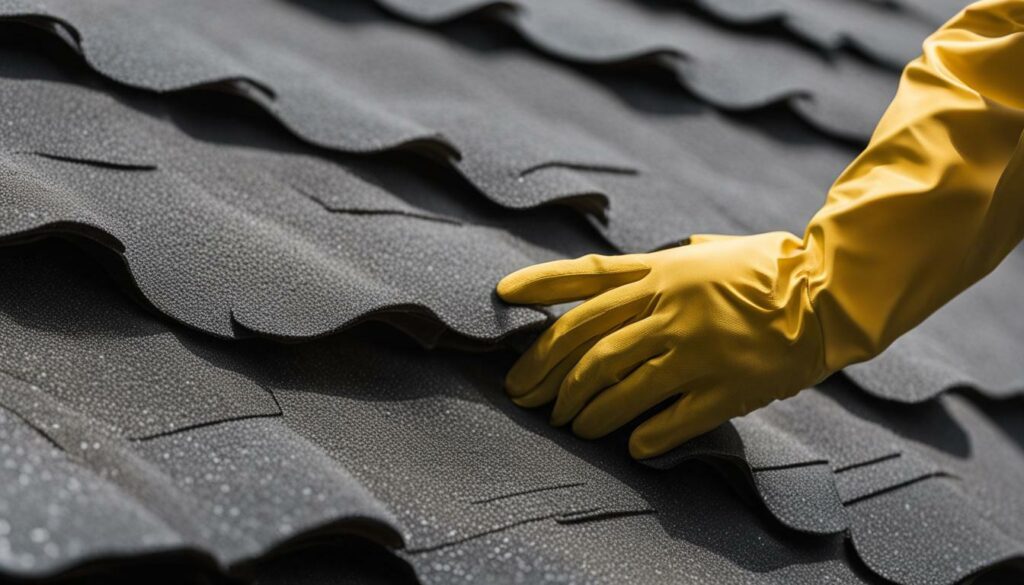
Cracked or broken shingles are a clear indication of hail damage. The impact of hailstones can cause shingles to split, creating visible cracks or breaks. Additionally, dented or bruised shingles may have a distorted appearance with noticeable depressions where the hailstones hit. These dents and bruises weaken the shingles’ structure and compromise their ability to protect your roof from the elements.
Another telltale sign of hail damage is missing granules on the shingles. Hail impact can dislodge granules, which are the protective layer of small, textured mineral particles on the surface of shingles. If you notice areas where the granules have been worn away or swept off, it is a strong indication of hail damage.
Size Matters: The Impact of Hailstone Size
The size of hailstones can also determine the extent of roof damage. Larger hailstones are more likely to cause severe damage, while smaller hailstones may only cause minimal or superficial damage. It is essential to consider the size of the hailstones when assessing the severity of hail damage on your roof.
In conclusion, recognizing hail damage on shingles is crucial for determining the severity of potential roof damage. Cracked or broken shingles, dented or bruised shingles, and missing granules are all signs of hail damage. By conducting a thorough inspection and understanding the impact of hailstone size, you can take the necessary steps to address any roof damage caused by hail.
Factors Affecting Hail Damage Severity
Several factors can determine how severe hail damage is on your roof, and understanding them is crucial for maintenance and repair. Wind speed and direction play a significant role in the extent of damage caused by hail. Higher wind speeds can propel hailstones with greater force, leading to more severe damage. The direction of the wind can also affect the angle at which hail strikes the roof, potentially causing different types of damage.
The size and density of hailstones also influence the severity of the damage. Larger hailstones tend to cause more extensive damage, especially when they hit the roof repeatedly. Additionally, denser hailstones are more likely to puncture or crack roofing materials, resulting in significant structural damage.
The type of roofing material used can also impact the level of hail damage. Some materials, like asphalt shingles, are more susceptible to damage from hail compared to more durable options like metal or impact-resistant roofing. Understanding the vulnerabilities of your specific roofing material can help you assess the potential severity of hail damage.
To better visualize the factors affecting hail damage severity, refer to the following table:
| Factor | Impact on Hail Damage Severity |
|---|---|
| Wind Speed and Direction | Higher wind speeds and unfavorable wind directions can increase the force and angle at which hailstones strike the roof, potentially causing more severe damage. |
| Hailstone Size and Density | Larger and denser hailstones are more likely to cause extensive damage, including punctures and cracks in roofing materials. |
| Roofing Material | The type of roofing material used can determine its vulnerability to hail damage. |
Taking these factors into account can help you assess the potential impact of hail on your roof and prioritize maintenance and repairs accordingly. Regular roof inspections and prompt repairs after hail storms are essential for keeping your roof in optimal condition and minimizing any potential damage.
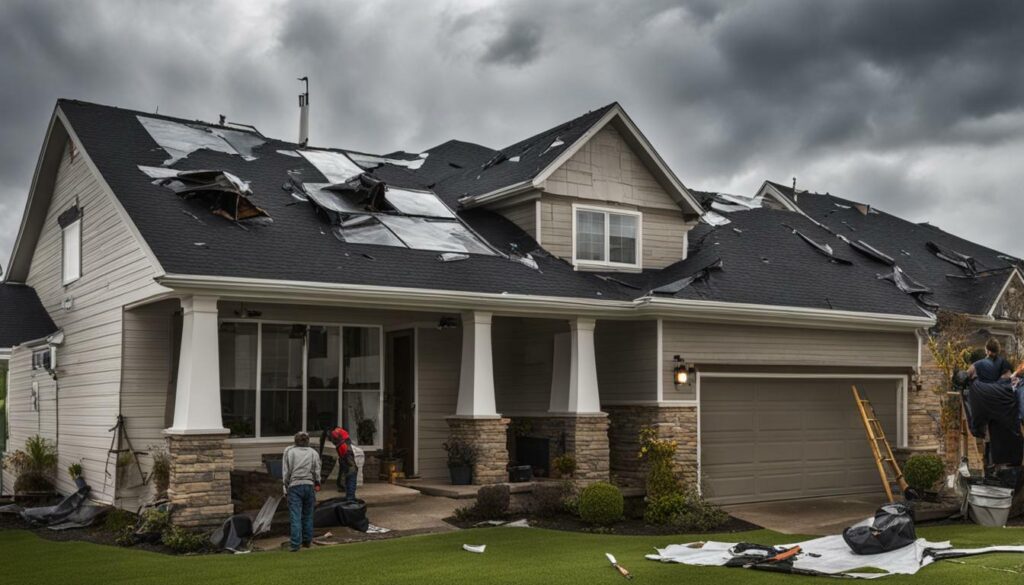
Taking preventive steps is vital to safeguard your roof from potential hail damage. By implementing these measures, you can reduce the risk of extensive damage and costly repairs. Here are some key strategies to protect your roof:
Regular Roof Inspections
Schedule regular roof inspections by a professional roofing contractor. They have the expertise to identify any potential issues and provide timely repairs. Inspections should be performed at least twice a year, with additional checks after severe weather events.
Impact-Resistant Roofing Materials
Consider using impact-resistant roofing materials, such as asphalt shingles with a Class 4 rating. These materials are designed to withstand hail impact and minimize damage. Consult with your roofing contractor to determine the best options for your home.
Trimming Trees and Shrubs
Ensure that trees and shrubs near your roof are regularly trimmed. During a hailstorm, overhanging branches can cause additional damage to your roof. By keeping them trimmed, you reduce the chances of debris impacting your roof and causing harm.
Remember, prevention is key when it comes to hail damage. Taking proactive steps to protect your roof can save you from costly repairs and potential insurance claims. Don’t wait until hail damage occurs. Act now to protect your home and ensure its long-term durability.
| Hail Damage Prevention Tips: |
|---|
| Regular roof inspections |
| Use impact-resistant roofing materials |
| Trim trees and shrubs near your roof |
Steps to Take If You Suspect Hail Damage
If you believe your roof has been damaged by hail, it’s essential to take prompt action to assess and address the issue. Follow these steps to ensure your roof is properly inspected and repaired:
- Contact a professional roofing contractor: It’s important to seek the expertise of a qualified roofing professional who can assess the extent of the damage. They will have the experience and knowledge to identify any hail damage and provide recommendations for repairs.
- File an insurance claim if necessary: If you have homeowner’s insurance that covers hail damage, it’s crucial to file a claim as soon as possible. Provide your insurance company with accurate and detailed information about the damage, including photos and documentation from the roofing contractor’s assessment.
- Schedule a roof inspection and repair: Once you’ve contacted a professional roofing contractor and filed an insurance claim, schedule a roof inspection to determine the exact extent of the damage. The contractor will thoroughly assess your roof and provide a comprehensive report outlining the necessary repairs. It’s important to address any hail damage promptly to prevent further issues, such as leaks and structural damage.
Remember, hail damage to roofs can worsen over time and may not always be visible to the untrained eye. That’s why it’s crucial to involve a professional roofing contractor who specializes in hail damage inspections and repairs. They have the expertise and tools to identify even subtle signs of damage that could lead to more significant problems down the line.
By taking these steps, you can ensure that your roof is properly inspected, repaired, and protected against future hailstorms. Don’t underestimate the importance of addressing hail damage promptly, as it can ultimately save you time, money, and headaches in the long run.
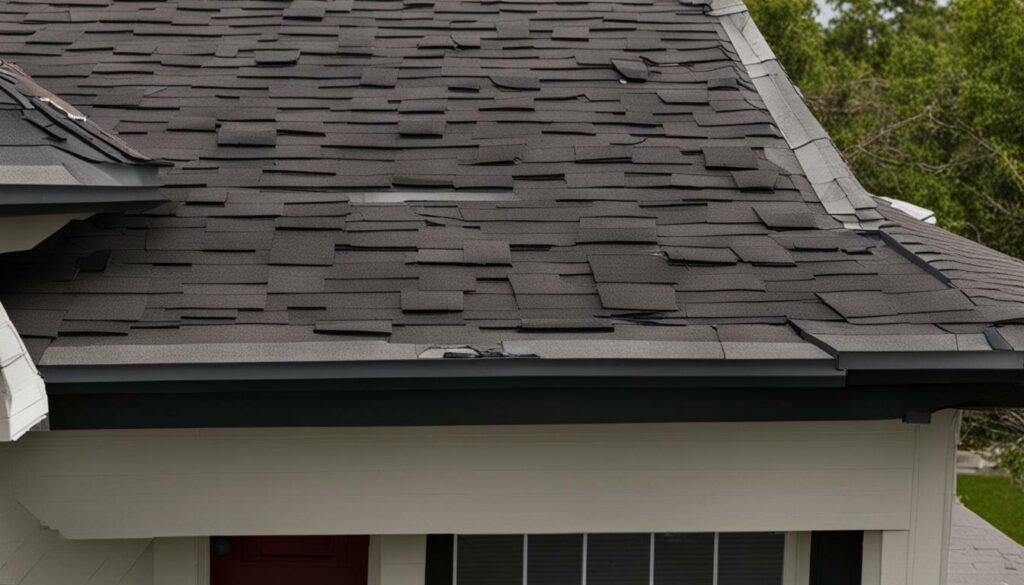
| Benefits of Taking Prompt Action | Consequences of Delaying |
|---|---|
| Prevents further damage to your roof | Increased risk of leaks and structural issues |
| Minimizes the potential for mold and water damage | Higher repair costs due to more extensive damage |
| Preserves the lifespan of your roof | Compromised structural integrity of your home |
Conclusion
By staying vigilant and promptly addressing hail damage, you can protect your roof and your home investment for years to come.
Hail damage to roofs can be a significant problem, but with the information provided in this guide, you will be equipped to spot and address any potential issues. Understanding what hail is and how it forms is the first step in recognizing the signs of hail damage. Look out for dented gutters, damage to siding and windowsills, and damage to air conditioners or outdoor items as indicators of possible roof damage.
To conduct a thorough inspection, focus on roof vents, chimneys, and shingles. Pay attention to any visible signs of hail damage, such as cracked or missing shingles, or dents and dings on metal components. Knowing what hail damage looks like on shingles will help you determine the severity of the damage and the necessary repairs.
Factors like wind speed and direction, hailstone size and density, and the type of roofing material can all impact the severity of hail damage. To protect your roof against future damage, consider investing in impact-resistant roofing materials and regularly trimming trees and shrubs near your roof that could potentially cause damage.
If you suspect hail damage on your roof, take immediate action. Contact a professional roofing contractor for an inspection and repairs. It is also important to file an insurance claim if necessary to ensure proper coverage and reimbursement. Remember, prompt attention to hail damage will help safeguard your roof and preserve the value of your home.
FAQ
Q: How can I spot hail damage on my roof?
A: Look for signs such as dented gutters, damage to siding and windowsills, and damage to air conditioners or outdoor items. Inspect roof vents, chimneys, and shingles for any visible damage.
Q: What does hail damage look like on shingles?
A: Hail damage on shingles can appear as dents, cracks, or missing granules. It may also cause shingles to become dislodged or misshapen.
Q: What factors contribute to the severity of hail damage?
A: The severity of hail damage can be influenced by factors such as wind speed and direction, hailstone size and density, and the type of roofing material.
Q: How can I protect my roof against hail damage?
A: To protect your roof against hail damage, consider getting regular roof inspections, using impact-resistant roofing materials, and trimming trees and shrubs that could potentially damage your roof.
Q: What steps should I take if I suspect hail damage to my roof?
A: If you suspect hail damage, it is recommended to contact a professional roofing contractor to assess the damage. Consider filing an insurance claim if necessary and schedule a roof inspection and repair.
